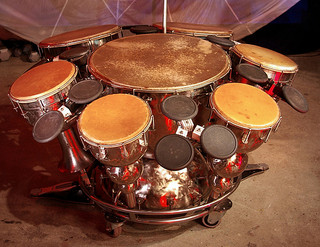The history of the drum stretches a long distance back into history. While we can assume that early humans and even animals used to hit rocks and other surfaces in the way we would use a percussion instrument, the first known use of a drum as we’d know it today occurred around 8,000 years ago.
Evidence from ancient symbols and hieroglyphs suggest that drums played a key role in ceremonial functions, predominantly based around royalty and the military, from as early as 6,000BC.
Such markings have been found across the world, with the most notable being in Central and South America in tribal caves and ancient settlements.
The earliest examples of a physical drum being found might also date back to this time, although the condition of the drums produced from alligator skin that have been found in China are difficult to date, so could be as much as 3,500 years younger.
The Use of Drums
Drums found in what was once Mesopotamia, accompanied by wall markings and other evidence, have been accurately dated to 3,000BC. In this part of the world, drums were an important part of society and would often have a place in religious events.
The most accurately chronicled historical use of drums is that associated with the Chinese army, particularly in the years 1,000 BC to the beginning of the Current Era. Drums would be used not only by military bands to motivate troops and set the beat, but also as a demonstration of strength and military might. There is evidence of drums playing a key role in the outcome of several battles in Ancient China around this time.
Sri Lanka is another country where drum use has been popular throughout history, and the instrument has been used as a communication tool between authorities and civilians for over 2,500 years.
More recently, the most famous use of drums from a military perspective has been in the English Civil War of the 17th century, where military drums as we know them today were first used. The purpose of using them was to relay commands via a pre-organized arrangement of beats.
Drums Today
Today, most people associate drums with drum kits used by modern bands. While variants of drum kits have been found throughout history, particularly as cymbals were invented, what we’d call the traditional drum kit took shape around the 1930’s.
However, as music evolved through the 20th century, drummers decided that they wanted a much wider range of sounds rather than the basic five or six you’d get from a basic kit. This led to the customization and growth of drum kits to some of the ones we see today, where a drummer will have a dozen drums and the same number of cymbals to play.
Modern products, such as electronic drums, have also become popular given the rise of electro and new age music, although even traditional musicians and artists are finding ways of incorporating these products into their work.
Drums in the Future
Drums will undoubtedly continue to evolve in the coming years. Whether we see the death of the traditional drum kit and the exclusive use of electronic varieties will be interesting to see, although it is more likely that musicians will continue to favour diversity.
John Wallace loves music and is currently using the online tutorials at Pro Music Tutor to improve his musical skills. John would love to start a band but isn’t sure he’d be able to dedicate enough time to achieve even modest success.

